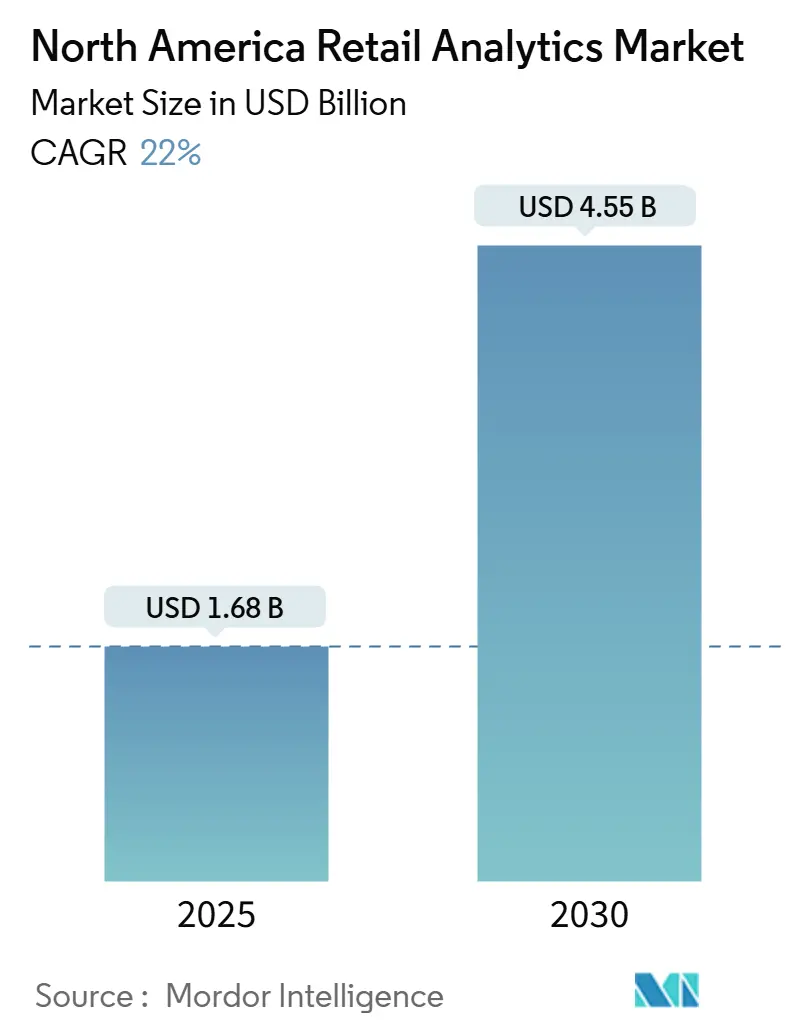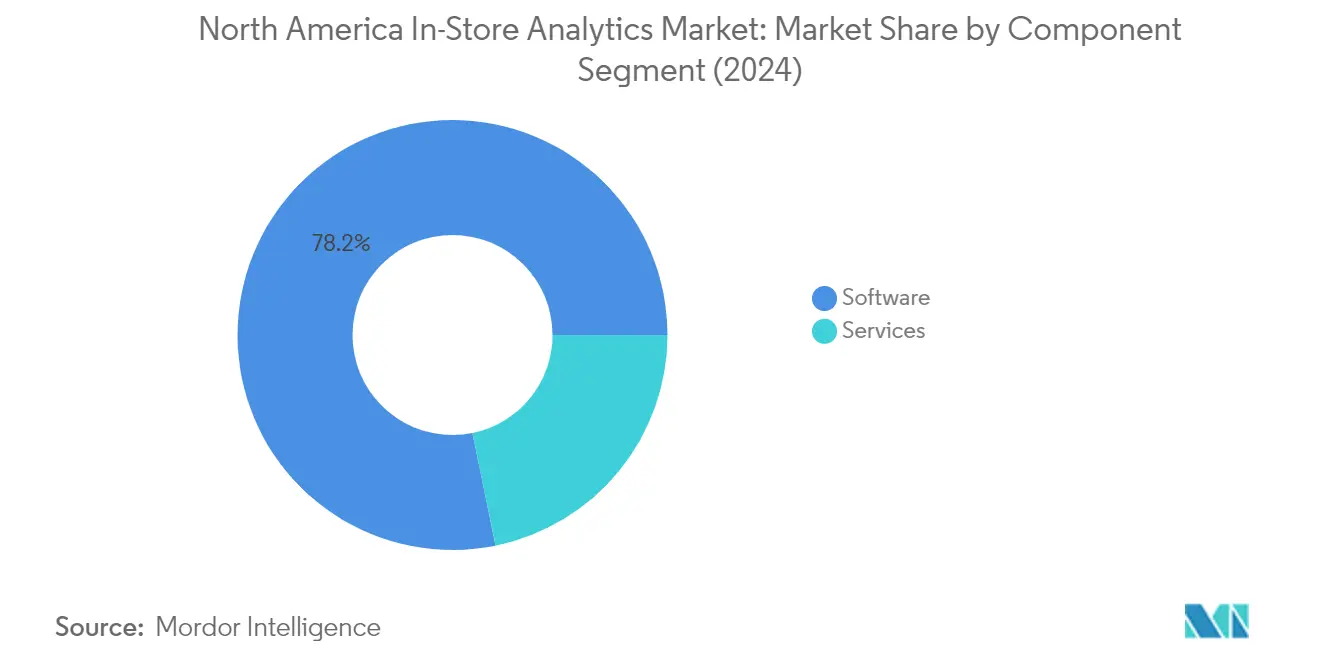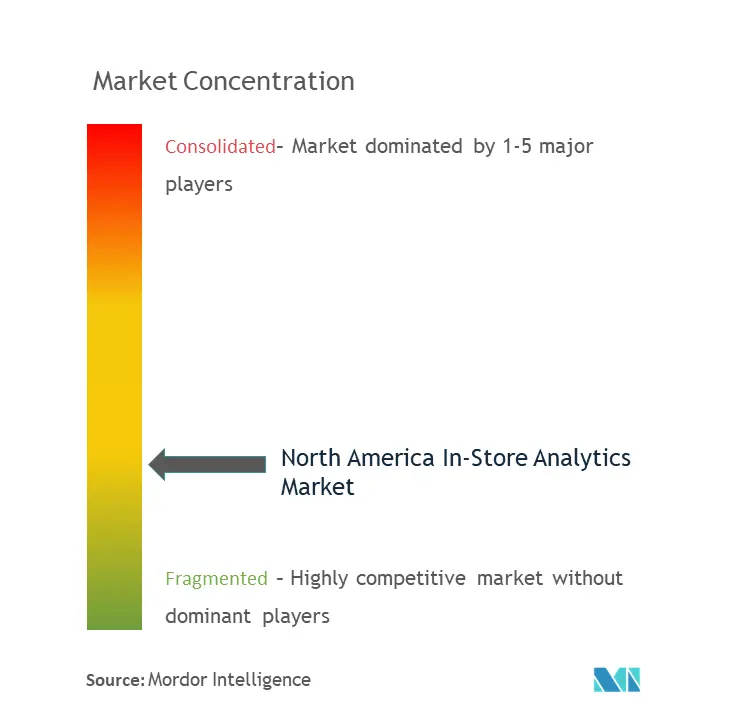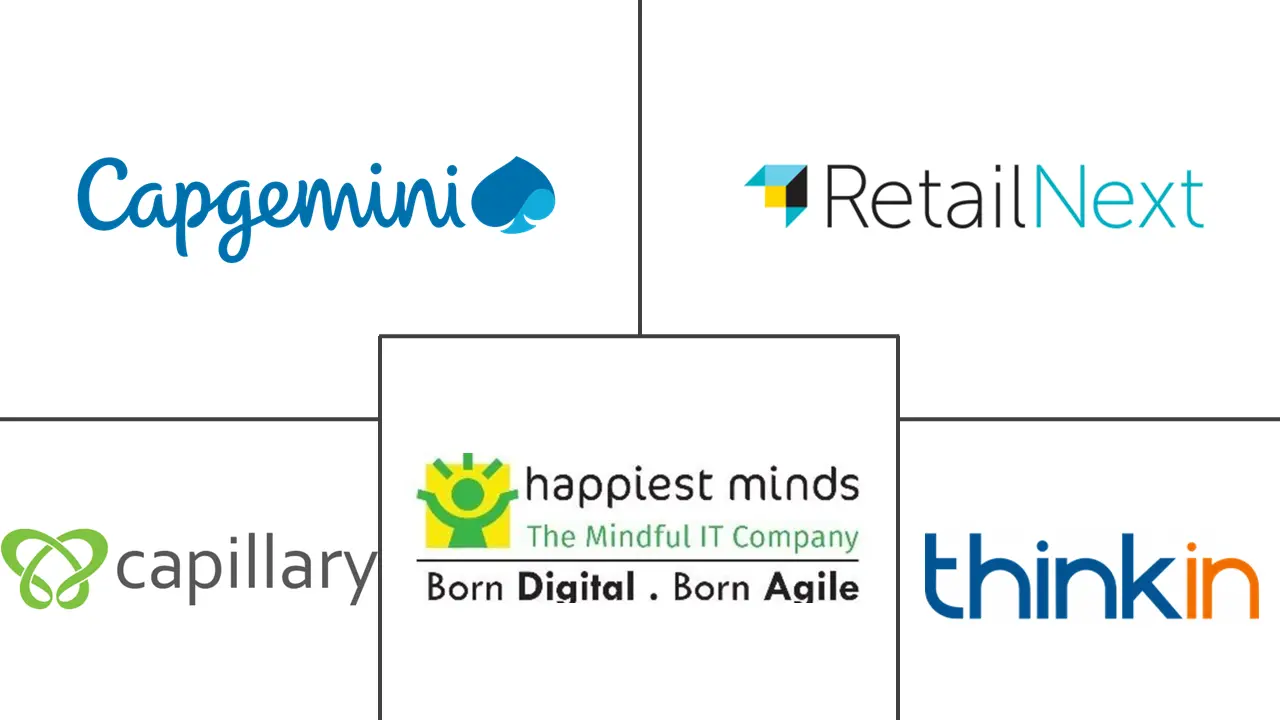
North America Retail Analytics Market Analysis by Mordor Intelligence
The North America Retail Analytics Market size is estimated at USD 1.68 billion in 2025, and is expected to reach USD 4.55 billion by 2030, at a CAGR of 22% during the forecast period (2025-2030).
The North American retail landscape is undergoing a significant digital transformation, driven by the increasing adoption of advanced retail analytics and intelligent technologies. Major retailers like Walmart, Costco, Kroger, Home Depot, and Target are leveraging smart carts with location beacons, pin-sized cameras, and store Wi-Fi networks to gather comprehensive retail insights. According to NewGenApps, retailers who fully leverage retail data analytics capabilities can optimize their operating margins by nearly 60%. This transformation extends beyond basic data collection to include sophisticated analysis of customer movement patterns, demographic profiling, and purchase behavior tracking, enabling retailers to make data-driven decisions about store layouts and merchandise placement.
The retail industry is witnessing a paradigm shift in how customer data is collected and utilized, particularly in light of evolving privacy regulations. The implementation of the California Consumer Privacy Act and Virginia's Consumer Data Protection Act has prompted retailers to reimagine their retail data management strategies, focusing more on first-party data rather than traditional third-party sources. This shift has led to innovative approaches in customer tracking and analytics, with retailers developing more transparent and consent-based methods of gathering customer insights while maintaining compliance with privacy regulations.
The integration of advanced technologies in physical retail spaces is creating new opportunities for customer engagement and operational efficiency. In June 2022, Amazon launched its Store Analytics service, marking a significant milestone in the commercialization of physical store data. This service provides marketers with valuable retail customer analytics into customer purchasing patterns and store interactions, demonstrating the growing sophistication of in-store analytics solutions. The US Bureau of Labor Statistics projects a 27.9% increase in employment demand for data scientists by 2026, highlighting the growing importance of data analytics expertise in the retail sector.
The industry is experiencing a significant labor market transformation, with the US Labor Department reporting a widespread labor crunch among grocery retailers. This challenge has accelerated the adoption of automated retail intelligence solutions and self-service technologies. Retailers are increasingly turning to artificial intelligence and machine learning technologies to optimize operations, from inventory management to customer service. These technologies enable retailers to maintain operational efficiency while providing enhanced shopping experiences through personalized recommendations, automated checkout systems, and real-time inventory management, despite workforce constraints.
North America Retail Analytics Market Trends and Insights
Increasing Data Volume in In-Store Operations
The retail industry is experiencing an unprecedented surge in data generation from various in-store operations, creating a compelling need for advanced retail analytics solutions. Point-of-sale systems, inventory management tools, customer tracking technologies, and digital touchpoints are generating massive amounts of operational data that retailers must effectively process and analyze. For instance, major retailers are implementing sophisticated systems that capture data from multiple sources—from traditional point-of-sale transactions to more novel sources like in-store sensors, surveillance systems, and customer mobile interactions. This wealth of data enables retailers to make more reliable decisions about inventory management, staff scheduling, store layouts, and promotional strategies.
The increasing complexity of retail operations and the need to process real-time data have made retail analytics solutions indispensable for modern retailers. Leading retailers like Walmart are leveraging data analytics to optimize their operations, as evidenced by their strong performance with revenue reaching USD 141.6 billion in Q1 2022, representing a 2.4% year-over-year increase. Solutions like IBM's Sterling Store Engagement platform are being adopted to provide real-time visibility into store inventory and customer data, accessible through both sales counters and mobile devices. Additionally, technologies like SCOPIX Store Operations Analytics are transforming video footage into actionable retail business intelligence, helping retailers monitor store conditions and benchmark performance metrics in real-time.
Need for Better Customer Service and Enhanced Shopping Experience
The evolution of consumer expectations and the competitive retail landscape have made superior customer service and enhanced shopping experiences crucial drivers for in-store analytics adoption. Retailers are increasingly focusing on creating seamless, personalized shopping experiences by leveraging data-driven retail insights about customer preferences, shopping patterns, and behavioral attributes. The retail sector's significance as the nation's largest private-sector employer, contributing USD 3.9 trillion to annual GDP and supporting 52 million working Americans, underscores the critical importance of enhancing customer service through technological innovation.
The shift toward hybrid shopping structures and omnichannel retail experiences has amplified the need for sophisticated analytics solutions. With e-commerce accounting for 14.8% of total U.S. retail sales in the third quarter of 2022, retailers are leveraging in-store analytics to bridge the gap between digital and physical shopping experiences. Solutions like video analytics and customer tracking systems help retailers understand customer movement patterns, optimize store layouts, and improve product placement strategies. Furthermore, the ongoing labor shortage in the retail sector has accelerated the adoption of automation and digital technologies, making retail predictive analytics tools essential for maintaining service quality while operating with reduced staff. These tools enable retailers to provide personalized recommendations, reduce checkout times, and ensure optimal product availability, ultimately enhancing the overall shopping experience.
Segment Analysis
Software Segment in North America Retail Analytics Market
The software segment dominates the North America retail analytics market, holding approximately 78% of the market share in 2024. This significant market position is driven by the increasing adoption of retail analytics software that enables real-time customer communication while reducing excessive expenditure. Software solutions in this market are helping retailers optimize their sales through strategic location planning, improved stock and assortment management, and consumer behavior tracking. These solutions are particularly valuable for retail merchandising analytics, enabling retailers to accurately forecast market trends by evaluating the impact of sales promotions and maintaining better control over inventory levels. The integration of artificial intelligence and machine learning capabilities within these software solutions has further strengthened their position in the market, enabling more sophisticated analysis of customer behavior and shopping patterns.

Services Segment in North America Retail Analytics Market
The services segment is emerging as the fastest-growing component in the North America retail analytics market, projected to grow at approximately 24% during 2024-2029. This rapid growth is primarily attributed to the increasing demand for professional and managed services integrated with in-store analytics solutions. The segment encompasses crucial support services, maintenance services, and regular update services that are becoming increasingly essential for retailers. The growth is further fueled by the retail sector's transformation from a product-centric to a customer-centric experience model, where digital technology and various communication channels are creating opportunities for more nuanced and personalized experiences. Service providers are focusing on delivering real-time analytics solutions, particularly for pop-up shops and specialized retail environments, demonstrating the segment's adaptability to evolving retail formats.
Segment Analysis: By Deployment
On-Premise Segment in North America Retail Analytics Market
The on-premise deployment segment continues to dominate the North American North America retail analytics market, holding approximately 70% market share in 2024. This significant market position is primarily driven by retailers' preference for complete control over their platforms, applications, systems, and data through their internal IT staff. The ability to customize software according to an organization's changing needs has been a key factor fueling the expansion of on-premises deployment. Many retailers handling sensitive customer credentials prefer this deployment strategy since the systems can be managed directly by company employees. Additionally, the on-premise solutions often include comprehensive services such as network design and integration, hardware installation and management, system maintenance, project planning, and IT training, enabling organizations to improve productivity, security, compliance, accountability, and cost-effectiveness.
Cloud Segment in North America Retail Analytics Market
The cloud deployment segment is experiencing rapid growth in the North America retail analytics market, with an expected growth rate of approximately 24% during 2024-2029. This accelerated growth is driven by the increasing adoption of cloud-based retail analytics systems that combine artificial intelligence and data analytics to help retailers create products aligned with customer feedback. Cloud computing enables businesses to streamline their supply chains and operations while providing customers with high-quality, seamless experiences. The technology allows retailers to process and analyze large amounts of data in real-time to gain strategic insights, particularly valuable for managing peak demand periods and holiday seasons. The integration of cloud computing into the retail sector has emerged as an essential tool for increasing consumer demand and retaining an ever-growing customer base.
Segment Analysis: By Organization Size
Large Enterprises Segment in North America Retail Analytics Market
Large enterprises continue to dominate the North America retail analytics market, holding approximately 65% market share in 2024. This significant market presence can be attributed to their substantial financial resources and ability to invest in comprehensive analytics solutions across multiple store locations. Large enterprises like Walmart, Costco, and Target are leveraging advanced in-store analytics capabilities to optimize their operations, enhance customer experience, and drive data-driven decision-making across their extensive retail networks. These organizations are particularly focused on implementing enterprise-wide solutions that can integrate with their existing technology infrastructure while providing scalable analytics capabilities. The segment's dominance is further strengthened by these enterprises' ability to deploy both cloud-based and on-premise solutions, depending on their specific requirements and security protocols. Large retailers are increasingly investing in sophisticated analytics tools to understand customer behavior, optimize store layouts, and improve retail inventory analytics across their numerous locations.
Small and Medium Enterprises Segment in North America Retail Analytics Market
The Small and Medium Enterprises (SME) segment is emerging as the fastest-growing segment in the North America retail analytics market, with an expected growth rate of approximately 23% during 2024-2029. This accelerated growth is primarily driven by the increasing availability of cost-effective analytics solutions specifically designed for smaller retail operations. SMEs are increasingly recognizing the value of data-driven decision-making in competing with larger retailers and are adopting cloud-based analytics solutions that offer flexibility and scalability without requiring significant upfront investments. The segment's growth is further fueled by the rising availability of Software-as-a-Service (SaaS) models that make sophisticated analytics tools more accessible to smaller retailers. These businesses are particularly interested in solutions that can help them understand customer behavior, optimize inventory management, and improve operational efficiency while maintaining a competitive edge in their respective markets.
Segment Analysis: By Application
Customer Management Segment in North America Retail Analytics Market
Customer Management has emerged as the dominant segment in the North America retail analytics market, commanding approximately 34% of the total market share in 2024. This significant market position is driven by retailers' increasing focus on collecting and analyzing customer data to enhance shopping experiences and drive sales growth. The segment's prominence is reinforced by the adoption of advanced technologies like occupancy estimation systems and queue monitoring solutions, which provide real-time insights into customer behavior and store operations. Major retail chains across North America are leveraging customer management analytics to understand shopping patterns, optimize store layouts, and deliver personalized experiences. The implementation of these solutions has become particularly crucial as retailers aim to bridge the gap between online and offline shopping experiences, enabling them to track customer journeys, analyze purchase decisions, and improve customer satisfaction levels.
Store Operations Management Segment in North America Retail Analytics Market
Store Operations Management represents the second-fastest growing segment in the North America retail analytics market, with a projected growth rate of approximately 22% from 2024 to 2029. This robust growth is attributed to the increasing adoption of digital technologies for streamlining store operations and improving operational efficiency. Retailers are increasingly investing in advanced analytics solutions to optimize workforce management, inventory control, and store layout optimization. The segment's growth is further fueled by the integration of AI and machine learning technologies, enabling real-time monitoring and decision-making capabilities. The adoption of these solutions has become particularly important as retailers seek to reduce operational costs, improve staff productivity, and enhance overall store performance through data-driven insights and automated processes.
Remaining Segments in Application Market Segmentation
The remaining segments in the market include Risk and Compliance Management, Merchandise Management, and Other Applications, each playing vital roles in the overall in-store analytics ecosystem. Risk and Compliance Management focuses on ensuring regulatory adherence and maintaining security protocols within retail environments. Merchandise Management enables retailers to optimize inventory levels, product placement, and supply chain operations through advanced analytics. The Other Applications segment encompasses various specialized solutions such as financial analysis, quality management, and sales analysis tools. These segments collectively contribute to creating a comprehensive analytics framework that enables retailers to make informed decisions across various aspects of their operations, from inventory management to loss prevention and regulatory compliance.
Geography Analysis
North America Retail Analytics Market in United States
The United States continues to dominate the North American in-store analytics landscape, commanding approximately 83% of the total market share in 2024. The country's retail sector has embraced digital transformation, with brick-and-mortar stores increasingly leveraging advanced retail analytics solutions to enhance customer experience and operational efficiency. Major retailers are investing in sophisticated in-store analytics tools to gather crucial data about consumer behavior, shopping patterns, and store performance. The integration of artificial intelligence (AI) and machine learning (ML) capabilities has enabled retailers to make data-driven decisions about store layouts, inventory management, and personalized marketing strategies. The market growth is further supported by the increasing adoption of smart shopping technologies, including smart carts, self-checkout systems, and advanced video analytics solutions that provide valuable insights into customer movement and engagement within stores.
North America Retail Analytics Market in Canada
Canada emerges as the fastest-growing market for in-store analytics solutions, with a projected CAGR of approximately 25% from 2024 to 2029. The Canadian retail landscape is experiencing a significant digital transformation, with retailers actively adopting innovative technologies to enhance their in-store operations. The market is witnessing increased implementation of advanced retail data analytics tools for customer behavior analysis, inventory optimization, and store performance monitoring. Canadian retailers are particularly focused on leveraging retail intelligence to create more personalized shopping experiences and improve operational efficiency. The government's support for digital initiatives and technological innovation in the retail sector has created a favorable environment for market growth. The integration of cloud-based analytics solutions and the rising demand for real-time customer insights are driving the adoption of in-store analytics across various retail segments in the country.
North America Retail Analytics Market in Other Countries
The North America retail analytics market primarily focuses on the United States and Canada, as these two countries represent the major retail markets in the region. Both markets demonstrate strong adoption of advanced retail technologies and analytics solutions, though with varying degrees of maturity and growth patterns. The retail sectors in both countries are characterized by their openness to technological innovation and commitment to enhancing customer experience through data-driven insights. The competitive landscape across these markets is marked by the presence of both global technology providers and local solutions developers, creating a dynamic ecosystem for retail business analytics innovation. The increasing focus on omnichannel retail strategies and the growing demand for seamless shopping experiences continue to drive the evolution of in-store analytics solutions across the region.
Competitive Landscape
Top Companies in North America Retail Analytics Market
The North America retail analytics market features prominent players such as Capgemini SE, RetailNext Inc., Happiest Minds Technologies, Capillary Technologies, ThinkIN SRL, and Trax Image Recognition, which lead the competitive landscape. These companies are heavily investing in product innovation, particularly in areas of artificial intelligence, machine learning, and computer vision technologies to enhance their retail analytics capabilities. Operational agility is demonstrated through cloud-based deployments and flexible solution architectures that can be tailored to various retail environments. Strategic partnerships with technology giants like Google Cloud, AWS, and Microsoft are becoming increasingly common to strengthen service offerings and market reach. Companies are expanding their footprint through both organic growth and strategic acquisitions, with a particular focus on developing comprehensive retail business intelligence suites that combine hardware sensors, software platforms, and professional services.
Market Dominated by Technology-Focused Global Players
The competitive landscape is characterized by a mix of global technology conglomerates and specialized retail analytics providers, with the former holding significant market share due to their established infrastructure and deep integration capabilities. Large players like SAP, Cisco Meraki, and Capgemini leverage their extensive partner networks and technological expertise to offer end-to-end solutions, while specialized providers like RetailNext and Trax focus on developing innovative, retail-specific analytics solutions. The market shows moderate consolidation, with larger players actively acquiring smaller, innovative companies to enhance their technological capabilities and expand their solution portfolios.
Merger and acquisition activity in the market is primarily driven by the need to acquire specialized capabilities in areas such as computer vision, artificial intelligence, and machine learning. Companies are also forming strategic alliances and partnerships to combine complementary strengths, with technology providers partnering with retail specialists to create more comprehensive solutions. The market structure favors companies with strong technological foundations and the ability to provide scalable, integrated solutions across multiple retail environments.
Innovation and Integration Drive Market Success
For incumbent players to maintain and increase their market share, the focus needs to be on continuous innovation in areas such as artificial intelligence, machine learning, and predictive analytics. Companies must invest in developing more sophisticated customer behavior analysis tools while ensuring seamless integration with existing retail infrastructure. The ability to provide comprehensive solutions that address multiple aspects of retail operations, from customer analytics to inventory management, while maintaining data privacy and security, will be crucial for market leadership.
New entrants and contenders can gain ground by focusing on specialized niches within the in-store analytics space, such as specific retail segments or particular analytical capabilities. The market shows relatively moderate buyer concentration, with large retail chains having significant bargaining power. While substitution risk is relatively low due to the essential nature of analytics in modern retail, regulatory concerns, particularly around customer privacy and data protection, are becoming increasingly important factors in solution development and deployment. Success in this market will increasingly depend on the ability to balance advanced analytical capabilities with robust privacy protection measures while providing clear return on investment for retailers. Companies that excel in retail data visualization and retail data mining will likely see significant opportunities for growth.
North America Retail Analytics Industry Leaders
Capgemini
RetailNext
Happiest Minds Technologies Limited
Capillary Technologies
ThinkIN
- *Disclaimer: Major Players sorted in no particular order

Recent Industry Developments
- July 2023: Acosta, an Acosta Group agency and a provider of commerce-centric solutions for the modern marketplace to retailers, brands, and foodservice providers, and Pensa Systems, a provider of digital retail shelf inventory management solutions, have partnered to boost revenue growth for CPG retailers and brands with highly accurate retail shelf visibility, strategic business insights as well as in-store execution. The shelf intelligence of the Pensa brand is being integrated into this new partnership by Acosta's analytics, in-store data collection, business intelligence, and merchandising solutions for all retailers on the market.
- January 2023: Google Cloud launched four new and upgraded AI technologies designed to help retailers automate in-store inventory checks and improve their e-commerce websites with more seamless and natural shopping experiences for their customers. This new shelf-checking AI solution, built using Google Cloud's Vertex AI Vision, uses Google's database of facts about people, places, and things, enabling retailers to recognize billions of products to ensure in-store shelves are right-sized and well-stocked.
North America Retail Analytics Market Report Scope
In-store analytics refers to the solutions and processes retailers use to measure different metrics, such as foot traffic, dwell time, and conversion rate, among others, within a retail store. Therefore, these solutions enable retailers to address key issues and increase workforce productivity, operations, and better consumer experience through merchandising, among other use cases.
The North America retail analytics market is segmented by component (software, services), by deployment (cloud, on-premise), by organization size (large enterprises, small and medium enterprises), by application (customer management, risk & compliance management, operation management, merchandise management), and country (United States and Canada). The market sizes and forecasts are provided in terms of value (USD) for all the above segments.
| Software |
| Services |
| Cloud |
| On-premise |
| Large Enterprises |
| Small and Medium Enterprises |
| Customer Management |
| Risk and Compliance Management |
| Store Operation Management |
| Marketing and Merchandizing |
| Other Applications |
| United States |
| Canada |
| By Component | Software |
| Services | |
| By Deployment | Cloud |
| On-premise | |
| By Organization Size | Large Enterprises |
| Small and Medium Enterprises | |
| By Application | Customer Management |
| Risk and Compliance Management | |
| Store Operation Management | |
| Marketing and Merchandizing | |
| Other Applications | |
| By Country | United States |
| Canada |
Key Questions Answered in the Report
How big is the North America Retail Analytics Market?
The North America retail analytics market size is expected to reach USD 1.68 billion in 2025 and grow at a CAGR of 22% to reach USD 4.55 billion by 2030.
What is the current North America Retail Analytics Market size?
In 2025, the North America retail analytics market size is expected to reach USD 1.68 billion.
Who are the key players in North America Retail Analytics Market?
Capgemini, RetailNext, Happiest Minds Technologies Limited, Capillary Technologies and ThinkIN are the major companies operating in the NA In-Store Analytics Market.
What years does this North America Retail Analytics Market cover, and what was the market size in 2024?
In 2024, the North America retail analytics market size was estimated at USD 1.31 billion. The report covers the NA In-Store Analytics Market historical market size for years: 2019, 2020, 2021, 2022, 2023 and 2024. The report also forecasts the NA In-Store Analytics Market size for years: 2025, 2026, 2027, 2028, 2029 and 2030.



